



















|
 |
|
 |

Baktria can field a wide variety of troops, probably the most diverse troops among all factions. Due to it's distance from Greece, Baktria makes use of more non-Hellenic troops, but still has enough Hellenic troops to fight in the Macedonian manner as most Diadochoi do, although Baktria is technically not among the real Diadochoi, but instead one of many "lesser Diadochoi" that defies Seleukid rule. Baktria can also field many Indian troops and steppe horse archers in addition. In fact, should India be subjugated and the Baktrian homelands be secured, the Baktrian king can have access to any unit type there is, except elite pikemen.
Pantodapoi (Hellenic Native Spearmen)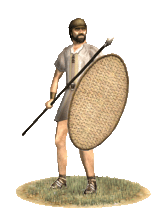 The most basic and numerous of the infantry units used by the non-European Successor States were the Pantodapoi infantry. These men were called from a variety of nationalities and were usually settled in certain areas for garrison duties and the like. There were Jews, Syrians, Cilicians, Persians, Assyrians, Native Egyptians, and many other peoples counted among their number. They are not particularly reliable soldiers, but they are certainly better than their eastern counterparts. They can give a good account of themselves in battle if deployed properly. They wear no armor, and have only a light shield for protection, so most other infantry will slaughter them in droves. They can fend off light cavalry for a time, if need be. The most basic and numerous of the infantry units used by the non-European Successor States were the Pantodapoi infantry. These men were called from a variety of nationalities and were usually settled in certain areas for garrison duties and the like. There were Jews, Syrians, Cilicians, Persians, Assyrians, Native Egyptians, and many other peoples counted among their number. They are not particularly reliable soldiers, but they are certainly better than their eastern counterparts. They can give a good account of themselves in battle if deployed properly. They wear no armor, and have only a light shield for protection, so most other infantry will slaughter them in droves. They can fend off light cavalry for a time, if need be.
Historically, the Pantodapoi were a group of various nationalities that were used as a militia levy and defensive group for towns and villages prone to raiding. While the name is conceptual (meaning, from everywhere), they were a standard fighting force of the day. They were trained rudimentarily, but had enough training to be counted as superior to many militia levies. They had some experience fighting off nomadic raiders, so they can be useful against light troops and some light cavalry.
Gund-i Palta (Eastern Skirmishers)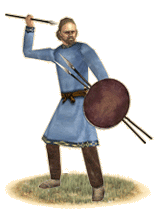 Armed with nothing but a small shield and a handful of javelins these men risk their lives in closing with the enemy with only the lightest of equipment. These men deploy in a cloud before the heavy infantry dashing back and forth to release their deadly missiles. These infantry skirmishers fought in open formations so as to maximize the number of men able to get a throw and minimize the effect of enemy missiles. Lacking armour, training and heavy weapons these light infantry stand no chance if committed to melee. Armed with nothing but a small shield and a handful of javelins these men risk their lives in closing with the enemy with only the lightest of equipment. These men deploy in a cloud before the heavy infantry dashing back and forth to release their deadly missiles. These infantry skirmishers fought in open formations so as to maximize the number of men able to get a throw and minimize the effect of enemy missiles. Lacking armour, training and heavy weapons these light infantry stand no chance if committed to melee.
Historically, most armies of the classical period found use for poorly equipped levies as skirmishers, very often as javelinmen, as these troops required relatively little training and financial investment, relying mostly on widespread natural skills and scant gear, while still providing some useful service.
Shuban-i Fradakhshana (Eastern Slingers)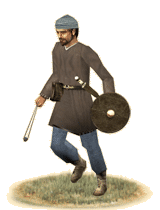 Slings are very easy and cheap to make and, yet, they are a respectable weapon. It is for this reason that they are so prevalent among the poverty-stricken hill tribes of the eastern lands. In battle, slingers are used as light skirmishers, troops with no armour or melee weapons but who rush forward against the enemy to pepper them with stones, only to flee when threatened. The best method of releasing a stone from a sling is by an underhand motion. These missiles can leave the sling in excess of 60 miles per hour. A well trained slinger can hurl a stone as far and as accurately as a good archer. The effect when they strike is nothing short of devastating. Slings are very easy and cheap to make and, yet, they are a respectable weapon. It is for this reason that they are so prevalent among the poverty-stricken hill tribes of the eastern lands. In battle, slingers are used as light skirmishers, troops with no armour or melee weapons but who rush forward against the enemy to pepper them with stones, only to flee when threatened. The best method of releasing a stone from a sling is by an underhand motion. These missiles can leave the sling in excess of 60 miles per hour. A well trained slinger can hurl a stone as far and as accurately as a good archer. The effect when they strike is nothing short of devastating.
Historically, slingers came from the shepherd boys of the highlands who use slings to herd sheep and goats. They stand guard in the upland pastures, and if they see an animal straying, they sling a stone in front of it to ward it back to safety. Ancient hand slings generally consisted of a single long strip of leather or woven wool, with a central "pocket" for the stone. The longer the sling, the greater would be its range. Long-range slings were about 3 feet long.
Thanvare Payahdag (Persian Archers)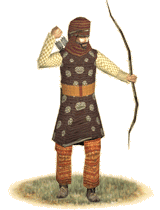 These men are skirmishers only and not inclined to close with enemy troops. These men would have the fully sleeved, long Persian Kapuris tunic. Often brightly coloured these traditional tunics would end just above the knees secured at the waist by a wide woven belt. They would also have a woolen cap, loose trousers and soft felt shoes. They would be armed with the powerful composite bow and a long dagger suitable only for defense. A plain leather quiver would be strung over their back. They would also have a simple woolen cap. These men are skirmishers only and not inclined to close with enemy troops. These men would have the fully sleeved, long Persian Kapuris tunic. Often brightly coloured these traditional tunics would end just above the knees secured at the waist by a wide woven belt. They would also have a woolen cap, loose trousers and soft felt shoes. They would be armed with the powerful composite bow and a long dagger suitable only for defense. A plain leather quiver would be strung over their back. They would also have a simple woolen cap.
Historically, the mainstay of the Parthian infantry were foot archers. These foot archers almost certainly represented the poorer elements of the various infantry levies of Parthia. The tradition of mounted archery in Parthia and the northern steppe peoples makes it almost inevitable that a massed levy would produce significant numbers of foot archers as well. The station usually assigned to these Parthian bowmen is behind the first line of spearmen and forward of them in skirmishing lines. These troops are vital to any armies plan, harassing and confusing enemy troops as they advanced, and shielding the flanks of the battle line from light cavalry and other enemy skirmishing units.
Nizagan-i Eranshahr (Persian Archer-Spearmen)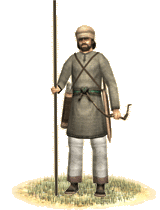 Armed with spear and bow these troops are not well regarded by their Greek masters having formed the bulk of the Old Persian army defeated by Alexander the Great. Seen as skirmishers and auxiliaries with the heavy Greek infantry forming the battle line. These Iranian Spearmen are recruited from the eastern reaches of the Iranian plateau and are very common in the armies of Baktria. They are the backbone of the traditional tribal militia and form a major part of the Baktrian tribal levy. They are armed with the traditional Iranian weapons, an 8' spear and a composite foot bow. A large decorated brown leather quiver of arrows would be slung on the left side with the bow case on the right. A long plain yellow tunic with close fitting sleeves at the wrists. The tunic would be held with an narrow embroidered Parthian linen belt. Trousers are worn under the tunic and are close fitting. Soft felt ankle shoes are secured with leather or fabric straps. Armed with spear and bow these troops are not well regarded by their Greek masters having formed the bulk of the Old Persian army defeated by Alexander the Great. Seen as skirmishers and auxiliaries with the heavy Greek infantry forming the battle line. These Iranian Spearmen are recruited from the eastern reaches of the Iranian plateau and are very common in the armies of Baktria. They are the backbone of the traditional tribal militia and form a major part of the Baktrian tribal levy. They are armed with the traditional Iranian weapons, an 8' spear and a composite foot bow. A large decorated brown leather quiver of arrows would be slung on the left side with the bow case on the right. A long plain yellow tunic with close fitting sleeves at the wrists. The tunic would be held with an narrow embroidered Parthian linen belt. Trousers are worn under the tunic and are close fitting. Soft felt ankle shoes are secured with leather or fabric straps.
Historically, the vast Iranian plateau gave rise to a form of infantry rarely seen in the west. Armed with 8' spear and composite short bow these infantry are well suited to conditions in the east facing nomadic enemies relying on long range archery to which they men are well able to respond. Nomadic cavalry is reluctant to engage close order troops and these men can fill both roles. They are versatile and can be dangerous if used properly. They are however no match for heavily armored infantry. Individually, they are skilled but not outstanding warriors, but their versatility ensures that they will be useful to any commander. These men however, prefer to rely on archery to inflict harm on the enemy. They can hold the line against weaker infantry and cavalry but they cannot be relied upon to put up an extended fight if the situation is not in their favor.
Pantodapoi Phalangitai (Hellenic Native Phalanx)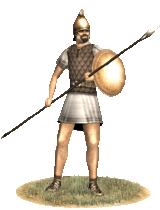 Pantodapoi Phalangitai are the standard levy of the Seleukidos Kingdom and others influenced by the Diadochoi, including Pontos. They are tough and reliable infantry, but are prone to rebellion and discontent, and are hence more expensive than their Makedonian contemporaries. They are mostly levies of Iudaioi, Syrioi, and Persai descent that are co-opted into the army. They fight as pikemen, with a soft leather cuirass, pikes, round Illyrian style shields and Phrygian caps. This makes them a viable pike unit, though they are less disciplined and more prone to flee than more reliable Hellenes and Makedonians that make up the Pezhetairoi. They can be counted upon to present a solid wall of spear points to the enemy, but their lack of discipline and intensive training makes them even more prone to a flanking attack. Pantodapoi Phalangitai are the standard levy of the Seleukidos Kingdom and others influenced by the Diadochoi, including Pontos. They are tough and reliable infantry, but are prone to rebellion and discontent, and are hence more expensive than their Makedonian contemporaries. They are mostly levies of Iudaioi, Syrioi, and Persai descent that are co-opted into the army. They fight as pikemen, with a soft leather cuirass, pikes, round Illyrian style shields and Phrygian caps. This makes them a viable pike unit, though they are less disciplined and more prone to flee than more reliable Hellenes and Makedonians that make up the Pezhetairoi. They can be counted upon to present a solid wall of spear points to the enemy, but their lack of discipline and intensive training makes them even more prone to a flanking attack.
Historically, the Seleukidoi and others used pike levies from their various subject peoples to make up parts of the battle line that were facing the enemy's least valuable troops. They gave decent accounts of themselves at many battles, but were the first line to break in the disasters at Raphia against the Ptolemies and in Makedonia against the Romaioi. They made up more and more of the Seleukidos battle line as time went on, due to the dwindling number of Hellene recruits that the army could draw upon for the pike units (most went to the more elite units), and more and more Asian peoples were put into the Pezhetairoi class and given land grants, to make up the loss, yet these more unreliable formations were still used in many places.
Kofyaren-i Kavakaza (Baktrian Light Infantry)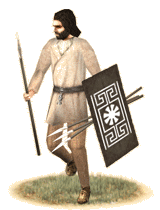 Many Iranian peoples inhabit the hills and mountains around Central Asia. As the nomads advance into these lands, they often avail themselves to these tough hillmen who can operate in lands that even a steppe pony may have difficulty. Armed with javelins and an axe, and armored only by a small buckler, these soldiers, like most Eastern infantry can not hope to survive in a fight against either settled infantry or nomadic cavalry. Even so, they can do heavy damage against unwary opponents, and are far more manuevarable than armor-laden heavy infantry. Willing to fight for most people who control their lands in return for money and booty, they can help the often infantry-challenged nomads even the odds in more conventional battles as well as sieges. Many Iranian peoples inhabit the hills and mountains around Central Asia. As the nomads advance into these lands, they often avail themselves to these tough hillmen who can operate in lands that even a steppe pony may have difficulty. Armed with javelins and an axe, and armored only by a small buckler, these soldiers, like most Eastern infantry can not hope to survive in a fight against either settled infantry or nomadic cavalry. Even so, they can do heavy damage against unwary opponents, and are far more manuevarable than armor-laden heavy infantry. Willing to fight for most people who control their lands in return for money and booty, they can help the often infantry-challenged nomads even the odds in more conventional battles as well as sieges.
Historically, Baktrian hillmen or at least soldiers like them have been around in the same lands for many years, serving the Persians and now the Greeks. From the earliest states to emerge in Central Asia to the recent establishments of Hellenic kingdoms, troops like these have often been levied for support infantry duty or just to fill the ranks of the army with greater numbers.
Tabargane Eranshahr (Eastern Axemen)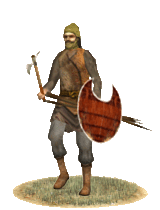 The Tabargân are steadfast warriors, aggressive and impetuous in temperament, valued by Iranians, and Hellenes alike for their ferociousness and courage. These hillmen are recruited as irregulars from the mountains of Iran, not least from the Zagros and Elburz ranges, areas that breed toughness and have done so for centuries. Though certainly not as disciplined as Hellenic heavy infantry, nor even comparably attired, They are armed with the Sagaris, or the "Persian pick-axe" (Ironically being Scythian in origin) which they wielded with skill, and a bundle of javelins, they were prepared for guerilla warfare tactics such as ambushes, surprise attacks and particularly fond of broken terrain where disciplined troops accustomed to fighting in formation would fare badly. This is facilitated by their light attire, as they bear no armour and the only true means of protection is a light shield, nimble movement and dauntless impetus, casting themselves into the fray. Distinguished by traditional Iranian highlander garb such as the Kyrbasia cap, baggy trousers, a woolen tunic, boots and a thick sheep-skin jerkin, these tough hillmen could almost be mistaken for shepherds or nomadic herders. However these hardy hillmen are nothing to scoff at, as the pick-axe could puncture helmets, and penetrate bronze and iron armour. The Tabargân were no less skilled with their javelins, in which the usage of javelin-thongs increased the stopping power and accuracy of the javelin, giving it a spin during flight. Using them properly, they will give a good account of themselves. Using them poorly on the other hand may prove suicidal and their dauntless bravery may quickly turn into fragile bravado. The Tabargân are steadfast warriors, aggressive and impetuous in temperament, valued by Iranians, and Hellenes alike for their ferociousness and courage. These hillmen are recruited as irregulars from the mountains of Iran, not least from the Zagros and Elburz ranges, areas that breed toughness and have done so for centuries. Though certainly not as disciplined as Hellenic heavy infantry, nor even comparably attired, They are armed with the Sagaris, or the "Persian pick-axe" (Ironically being Scythian in origin) which they wielded with skill, and a bundle of javelins, they were prepared for guerilla warfare tactics such as ambushes, surprise attacks and particularly fond of broken terrain where disciplined troops accustomed to fighting in formation would fare badly. This is facilitated by their light attire, as they bear no armour and the only true means of protection is a light shield, nimble movement and dauntless impetus, casting themselves into the fray. Distinguished by traditional Iranian highlander garb such as the Kyrbasia cap, baggy trousers, a woolen tunic, boots and a thick sheep-skin jerkin, these tough hillmen could almost be mistaken for shepherds or nomadic herders. However these hardy hillmen are nothing to scoff at, as the pick-axe could puncture helmets, and penetrate bronze and iron armour. The Tabargân were no less skilled with their javelins, in which the usage of javelin-thongs increased the stopping power and accuracy of the javelin, giving it a spin during flight. Using them properly, they will give a good account of themselves. Using them poorly on the other hand may prove suicidal and their dauntless bravery may quickly turn into fragile bravado.
Historically, the northern Iranian highlands are known for their hardy mountaineers who held all transgressors at bay. These men of the mountains were lightly ruled by all Persian Grandees who valued their warrior skills over what meagre income their mountain homes might bring. These men would be recruited from the warlike Gîlânî and Dailamî tribesmen of Verkhânâ (Hyrcania), and other similar peoples of northern Media. The earliest origins of these people are unknown, although the Dailamites could be the descendants of such ancient peoples as the Delumďoi (Delumioi) and Karduchoi (Kadousioi or the Cadusians) mentioned by Ptolemy in 2 AD. Classical historians mention Dailamites, 'Dolomites' or other very similar names repeatedly and their name is particularly mentioned in context with the later Byzantine Varangian Guard. Due to the mingling of migrant tribes with the indigenous residents of the region, several new clans were formed, of which, the two tribes of 'Gill' and 'Daylam' formed a majority. In the 6th century BC, the inhabitants of Gîlân allied with Kűroush (Cyrus) the Great and overthrew the Medes helping to establish the Achaemenid Persian Empire. The Dailamites would later during the Sassanid dynasty form a core of heavy infantry with fine equipment including brightly painted shields and two-pronged javelins, meant to be pitted against the finest Roman infantry. However, that is a long way from the continuously more declining irregular force, the Takâbarâ as they were called by the Achaemenids, and in Parthian history, the Tabargân are merely the residue of the Iranian highlander spirit, not exclusive to the Elburz range but to all areas of Iran where the environment breeded toughness.
Peltastai (Hellenic Heavy Skirmishers)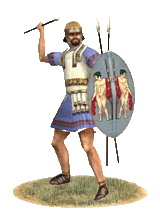 The Peltastai is a type of elite skirmisher that sacrifices heavy arms and armor for mobility and range. They are armored in linen and carry a medium sized ovular shield. Originally, they carried a crescent shaped 'pelta' shield, originated in Thrake and gave the peltastai their name, but this was phased out in the fourth century. Their armaments consist of several javelins and a sword. This panoply makes them light and mobile, but still able to engage in melee after their javelins have been thrown. They are a versatile unit but one must remember that their primary arms are javelins, and they are not equipped to stand toe to toe with heavier infantry. Their role is one of speed, harassment, and critical flanking maneuvers. The Peltastai is a type of elite skirmisher that sacrifices heavy arms and armor for mobility and range. They are armored in linen and carry a medium sized ovular shield. Originally, they carried a crescent shaped 'pelta' shield, originated in Thrake and gave the peltastai their name, but this was phased out in the fourth century. Their armaments consist of several javelins and a sword. This panoply makes them light and mobile, but still able to engage in melee after their javelins have been thrown. They are a versatile unit but one must remember that their primary arms are javelins, and they are not equipped to stand toe to toe with heavier infantry. Their role is one of speed, harassment, and critical flanking maneuvers.
Historically, the peltastai were often hoplitai or pezhetairoi equipped to fight in the manner of a skirmisher. This meant that they were adept melee combatants as well as being deadly with their javelins. Peltastai were used to great effect on ancient battlefields but by 270 BC the thureophoros was becoming the dominant melee skirmisher and the peltastai were carrying more javelins and were used in a manner that was consistent with this. This was simply a matter of specialization, and it did not mean that peltastai would be any less effective if deployed correctly. Their light armament makes them extremely fast, but tends to be to their detriment in melee combat. They were mostly used in the role of supporting missile troops who charged in at the last moment, after they had spent all their javelins. The great Athenian general Iphikrates is credited with the invention of the peltast as a distinct unit, and it is he that first employed them in this manner to great effect against the heavier armored and better trained hoplitai of Sparte.
Thureophoroi (Hellenic Spearmen)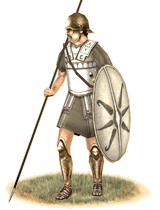 Thureophoroi were a new class of Hellenic infantry that was designed to both augment the phalanx and provide a type of soldier in between the phalangite and the peltastai that was able to both skirmish and fight in melee effectively. These men provide an extremely mobile force that can hit hard with their heavy javelins then rush in to flank pike units. They are well armed and armored for the task, having stout bronze helms, linen armor, an almond shaped thureos shield, heavy javelins, and a stout spear. They are highly versatile infantry, akin in spirit to the legionaries of Rome. They are a highly effective force of heavy infantry that is in the forefront of Hellenic military know-how. Thureophoroi were a new class of Hellenic infantry that was designed to both augment the phalanx and provide a type of soldier in between the phalangite and the peltastai that was able to both skirmish and fight in melee effectively. These men provide an extremely mobile force that can hit hard with their heavy javelins then rush in to flank pike units. They are well armed and armored for the task, having stout bronze helms, linen armor, an almond shaped thureos shield, heavy javelins, and a stout spear. They are highly versatile infantry, akin in spirit to the legionaries of Rome. They are a highly effective force of heavy infantry that is in the forefront of Hellenic military know-how.
Historically, Thureophoroi were used as harassing and flanking troops by the successor states. Though they were often described by Latin writers as copies of the legion, it is debatable whether they were developed with knowledge of warfare in Italy or not. Most Thureophoroi were Pezhetairoi, middle class property owners with voting rights, and as such, they were well able to devote time to training and practice and were highly disciplined and courageous troops. Despite their obvious advantages, or perhaps because of them, there was a lot of confusion as to how to utilize these new soldiers. As were deadly in the extreme to the less mobile phalanx units they forced a, much resisted, revaluation of Hellenic warfare. Perhaps for this reason the Diodachoi tended to used them conservatively, except for the Seleukidai, who took to these new soldiers quite well. The city-states of Hellas used them even more frequently against the armies of Makedonia, and were often able to hold the more powerful kingdom at bay. Still, their uses were limited in scope and not as widespread as their versatile and deadly role would have indicated. This is the fault of period commanders, however, and a more astute or innovative commander might have realized their potential in conjunction with the more static phalanx.
Thorakitai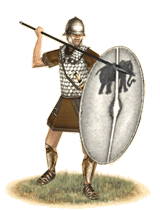 The Thorakitai represent the second evolution of the concept of the Theurophoroi, and show definite influence by the Romaioi in their implementation. They are armored in mail and carry heavy javelins instead of the lighter javelins carried by the Thureophoroi. They are more expensive and less mobile than their more lightly armored companions, but make excellent shock troops for any Hellenic army. They are best utilized on the flanks of the phalanx to either flank the enemy while the phalanx pins them, or prevent enemy flankers from attacking the phalanx's vulnerable flanks. They are best used in combination with the lighter Thureophoroi, who can support them with extra javelins and more importantly, speed, to make sure they are not surrounded. The Thorakitai represent the second evolution of the concept of the Theurophoroi, and show definite influence by the Romaioi in their implementation. They are armored in mail and carry heavy javelins instead of the lighter javelins carried by the Thureophoroi. They are more expensive and less mobile than their more lightly armored companions, but make excellent shock troops for any Hellenic army. They are best utilized on the flanks of the phalanx to either flank the enemy while the phalanx pins them, or prevent enemy flankers from attacking the phalanx's vulnerable flanks. They are best used in combination with the lighter Thureophoroi, who can support them with extra javelins and more importantly, speed, to make sure they are not surrounded.
Historically, the Thorakitai were used much like the Thureophoroi, but more rarely and later on. They were expensive soldiers, and one had to be fairly wealthy to equip one's self as a Thorakites. They were only used in any real numbers by the Seleukidai and the city-states of Hellas. They were never used to their full potential until the Romaioi raised legions in Hellas, and the type of fighting practiced by the Romaioi Legions and Thorakitai became the norm rather than the exception.
Pezhetairoi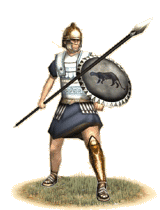 The Pezhetairoi are heart of the military machine of all the Diodachoi kindgoms. They are well disciplined and highly motivated pikemen that are armed and armored to the teeth. They are armored in a linen cuirass, a Thraikian cap, a bronze greave on the left leg, stout boots, good bracers, and reinforced shoulder pads made from hardened linen (due to their experience with the deadly curved swords of Thrace). They have Illyrian style round shields attached to their bodies by leather straps that help support the weight of the shield and keep their hand free to grasp the long and unwieldy sarissa. They are defensive infantry par excellence and are the anvil of the two part Makedonian system of warfare, the heavy cavalry being the hammer. They should be used to anchor enemy soldiers while the Theurophoroi harass the flanks and the heavy cavalry smashes into the flanks and rear. The Pezhetairoi are heart of the military machine of all the Diodachoi kindgoms. They are well disciplined and highly motivated pikemen that are armed and armored to the teeth. They are armored in a linen cuirass, a Thraikian cap, a bronze greave on the left leg, stout boots, good bracers, and reinforced shoulder pads made from hardened linen (due to their experience with the deadly curved swords of Thrace). They have Illyrian style round shields attached to their bodies by leather straps that help support the weight of the shield and keep their hand free to grasp the long and unwieldy sarissa. They are defensive infantry par excellence and are the anvil of the two part Makedonian system of warfare, the heavy cavalry being the hammer. They should be used to anchor enemy soldiers while the Theurophoroi harass the flanks and the heavy cavalry smashes into the flanks and rear.
Historically, the Pezhetairoi are the classic Alexandrian phalanx. They were used to great effect against the Persai, Medoi, Baktrioi, Indoi, Phoinikoi, and many, many others. They are an effective force and have not changed much over the centuries. The Romaioi were able to defeat them as easily as they did for two main reasons. One, the Romaioi army was at a high state of readiness and tactical prowess after defeating the Karchedoi. Two, the heavy cavalry arm of the Diodochoi armies had degenerated to the point where they were no longer able to field significant numbers to fulfill their part of the hammer and anvil tactic of Alexandros. There were also many lesser reasons, numbering among them the misuse of the Thureophoroi, the under use of Peltastai, and the lax state of warfare that the Diodachoi states were used to. In any case, the phalanx was not as anachronistic or inflexible as widely believed; it was simply misused and under-supported. In the thirteenth century and onwards, pikemen in similar formations were able to work wonders with more capable generals and a better cavalry arm. Do not under appreciate pikemen, for they are still a war winning force.
Prodromoi (Successor Medium Cavalry)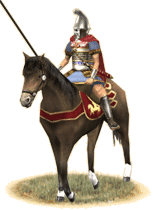 Prodromoi are the lightest of the Diadochoi melee cavalry and can be counted upon as superb flanking, raiding, and screening cavalry. They are well trained for light cavalry, but are still lightly armed and armored. They are not meant to be used as shock cavalry and will not roll up an enemy battle line in a thunderous charge, but instead make viable flanking cavalry which can quickly provide support where it is needed and be used to counter light missile troops of both the foot and mounted varieties. Their spears, shields, and linen armor give them some staying power, but they should not be used to in protracted melee for any great amount of time. Prodromoi are the lightest of the Diadochoi melee cavalry and can be counted upon as superb flanking, raiding, and screening cavalry. They are well trained for light cavalry, but are still lightly armed and armored. They are not meant to be used as shock cavalry and will not roll up an enemy battle line in a thunderous charge, but instead make viable flanking cavalry which can quickly provide support where it is needed and be used to counter light missile troops of both the foot and mounted varieties. Their spears, shields, and linen armor give them some staying power, but they should not be used to in protracted melee for any great amount of time.
Historically, the Seleukidai and Makedones used the smaller and weaker members of the nobility to form a quick and powerful light cavalry force that could decide an engagement on its own. Since these men are nobles, they have good staying power, as was evidenced by their widespread use in many battles. They are quick, and can be used to chase down missile cavalry when there is a need, due to the fact that they ride fast Thessalian horses and are relatively slight statured men. The Seleukidai use them as an effective counter to the Parthoi horse archers, much like the Hungarians of a later era did against the Turks.
Baktrioi Hippeis (Baktrian Medium Cavalry)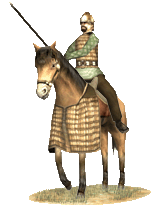 The Baktrioi Hippeis under Hellenic rule represents a cultural fusion that makes the legendary horsemen of Baktria even more formidable. Armed with an axe and a two-handed lance, these men are armored in the finest Hellenic bronze, and fight with a level of ferocity not usually found in regulars of their type and station. While not as heavily armored as kataphraktoi, they are still able to hold their own against most other cavalry, in that they are far more heavily armored than is the norm. They should be used as shock cavalry, but must be wary of heavy infantry or other heavy cavalry. The Baktrioi Hippeis under Hellenic rule represents a cultural fusion that makes the legendary horsemen of Baktria even more formidable. Armed with an axe and a two-handed lance, these men are armored in the finest Hellenic bronze, and fight with a level of ferocity not usually found in regulars of their type and station. While not as heavily armored as kataphraktoi, they are still able to hold their own against most other cavalry, in that they are far more heavily armored than is the norm. They should be used as shock cavalry, but must be wary of heavy infantry or other heavy cavalry.
Historically, the Baktrioi Hippeis were among the most famous in the ancient world. Arrian relates to us the curious story of their Nisean horses being fed only flowers, such was the quality of the breed and the delicate nature of their diet. This made a strong, powerful horse that was to form the crucible of war horses for the great eastern kingdom. Representing a fusion of Hellenic and Iranian, these men made up the local nobility in which 'mixed' families often ended up. They were not wholly Hellenic and not wholly Baktrioi, but they were loyal enough to the State to provide heavy horsemen that helped stem the tide of being surrounded by foemen.
Baktrioi Hippotoxotai (Baktrian Horse-Archers)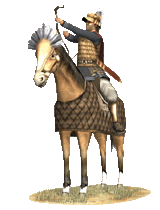 The Greeks and Iranians of Baktria had a significant problem when it came to combatting the mounted archers of the steppe, notably that they had no mounted archers to combat the nomads! In addition to hiring nomads of their own, the Baktrian kings began to field a professional corps of their own horse archers, taken from local Greek and Iranian stock. These men are armed with composite bows and nomadic-style blade. Their armor is purely Hellenistic, however, being a scale-covered linothorax, Illyrian shield, and Phrygian helmet. The Greeks and Iranians of Baktria had a significant problem when it came to combatting the mounted archers of the steppe, notably that they had no mounted archers to combat the nomads! In addition to hiring nomads of their own, the Baktrian kings began to field a professional corps of their own horse archers, taken from local Greek and Iranian stock. These men are armed with composite bows and nomadic-style blade. Their armor is purely Hellenistic, however, being a scale-covered linothorax, Illyrian shield, and Phrygian helmet.
Historically, the Baktrian horse archers were not huge in number, but they made up for this with a powerful determination and more armor and training than their nomadic enemy. They can be used as normal horse archers or in a supporting melee cavalry role.
Baktrion Agema (Baktrian Royal Guard)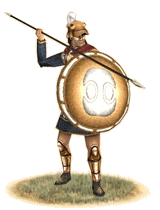 The Baktrian kingdom had it's own elite guard, shown so beautifully in golden statuary throughout their prominent enclaves. These men are armed with spear and blade, and armored in a tough cuirass and boeotian helmet of a design unique to their corps. They are the elite infantry of Baktria, and form the bulwark of Baktria's opposition to it's rabid enemies. They are a versatile phalanx, adapt at their prescribed task, but equally profficient when charging as melee fighters. The Baktrian kingdom had it's own elite guard, shown so beautifully in golden statuary throughout their prominent enclaves. These men are armed with spear and blade, and armored in a tough cuirass and boeotian helmet of a design unique to their corps. They are the elite infantry of Baktria, and form the bulwark of Baktria's opposition to it's rabid enemies. They are a versatile phalanx, adapt at their prescribed task, but equally profficient when charging as melee fighters.
Historically, the Baktrians had a lack of professional guards, which they tried to rectify by training recent arrivals from independent and semi-autonomous Greek settlements outside of their kingdom, seeking a secure region for protection after their succession from the Seleucid kingdom. These Greeks eventually formed the nucleus of this powerful and feared group of soldiers, which was later supplimented by local Greeks.
Peltastai Makedonikoi (Hellenistic Elite Infantry)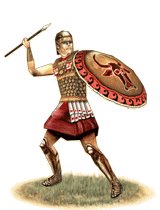 Hail, Basileu! These men are the Peltastai and among the elite of your army. Men in their prime and drawn from the upper echelons of society they have been fitted with fine armor, a sword, and javelins. They excel in assault where their javelins can scatter defenders from breaches in defenses made by your siege engines. In the open field, their equipment, lighter in comparison to the heavily armed Hypaspistai, makes them adept at flanking the enemy battle line or exploiting openings made by your other troops. Hail, Basileu! These men are the Peltastai and among the elite of your army. Men in their prime and drawn from the upper echelons of society they have been fitted with fine armor, a sword, and javelins. They excel in assault where their javelins can scatter defenders from breaches in defenses made by your siege engines. In the open field, their equipment, lighter in comparison to the heavily armed Hypaspistai, makes them adept at flanking the enemy battle line or exploiting openings made by your other troops.
Historically the elite Peltastai Makedonikoi appear at some point during the late 3rd century as the guard of the Antigonid kings and later with the other Diadochoi. The precise moment is not known due to scarcity of information concerning period between the Battle of Ipsos and start of second Punic War. It is from both Polybios and inscriptions found in Makedonia that we learn of them; that they were among the most fit Makedones available to the king; and likely the sons of noble families. They were younger than 35 and so at the peak physical strength for the average man. Their role in war was similar to that of Hypaspistai in the army of Alexander the Great: assault of fortifications, supporting light troops in broken terrain, and performing special missions that required both skill and strength. In set battles they could be equipped with sarissai and fight with the phalanx positioned in the place of honor at the right wing close to the king. Commanders of the Peltastai were among the most important persons in kingdom, as evidenced by Antigonos Doson's naming the contemporary commander of the unit, along with four others, as protector of a young Phillipos V.
Hellenikoi Kataphraktoi (Hellenic Cataphracts)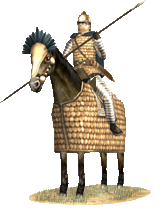 After suffering heavy losses to the Parthai and Armenioi Kataphraktoi, the Seleukidos and Baktrian empires produced their own versions of these heavy horsemen, both adapting the tactics and style of warfare to Hellenic technology and using superior metalwork to make them even more heavily armored. They are armored in an expensive combination of lamellar armor and chain, with heavy felt sandwiched in the middle. The resulting armor is tough and flexible, but offers outstanding protection. They are to be used as heavy shock cavalry, and have staying power in melee because of the sheer weight of their armor. They are slightly heavier than their Parthai counterparts, but lack the deadly maces that the Parthai carry and also the élan of their elite Parthai counterparts. Their horses are more heavily armored than those of the Hetairoi, but they lack the characteristic fierceness and discipline of the elite Diadochoi cavalry. After suffering heavy losses to the Parthai and Armenioi Kataphraktoi, the Seleukidos and Baktrian empires produced their own versions of these heavy horsemen, both adapting the tactics and style of warfare to Hellenic technology and using superior metalwork to make them even more heavily armored. They are armored in an expensive combination of lamellar armor and chain, with heavy felt sandwiched in the middle. The resulting armor is tough and flexible, but offers outstanding protection. They are to be used as heavy shock cavalry, and have staying power in melee because of the sheer weight of their armor. They are slightly heavier than their Parthai counterparts, but lack the deadly maces that the Parthai carry and also the élan of their elite Parthai counterparts. Their horses are more heavily armored than those of the Hetairoi, but they lack the characteristic fierceness and discipline of the elite Diadochoi cavalry.
Historically, Hellenistic Kataphraktoi were at least as good as their Parthai enemy, but most Seleukidoi commanders did not quite understand how to use this cavalry. They won great victories over the Parthai when supporting the tougher and more elite Hetairoi, compelling the Parthai to settle for a peace treaty and suzerainty over some of the Seleukidoi eastern possessions. They passed into history when most of the unit was bribed by Pompey during his conquest of the east. They formed the basis for the Romaioi kataphraktoi of later ages.
Somatophylakes Strategou (Baktrian Early Bodyguard)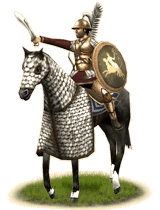 It was the most daring of Hellenes who traversed more than 5000 miles from mainland Hellas to join their Ionian brethren (former Persian exiles) in colonizing Baktria. Of those, the bravest became expert horsemen sworn to defend the Basileus of Baktria or members of his family with their lives. Going in battle with the long thrusting "Xyston" spear as a primary weapon and a "Kopis" short slashing sword for melee. They wore a metal cuirass and a Boetian helmet. For lower body protection they wore a lammelar armour for the thighs and leg protectors, the "perikneimides". As a unique characteristic, they carried a palm branch on their back, possibly to distinguish themselves from the rest of the Hetairoi cavalry. Their exemplary bravery and dedication was such that they were immortalized on most of the coins their Kings minted. Not as armored as the Hetairoi Kataphraktoi who succeeded them, they were none the less admired and envied throughout the Hellenic world! It was the most daring of Hellenes who traversed more than 5000 miles from mainland Hellas to join their Ionian brethren (former Persian exiles) in colonizing Baktria. Of those, the bravest became expert horsemen sworn to defend the Basileus of Baktria or members of his family with their lives. Going in battle with the long thrusting "Xyston" spear as a primary weapon and a "Kopis" short slashing sword for melee. They wore a metal cuirass and a Boetian helmet. For lower body protection they wore a lammelar armour for the thighs and leg protectors, the "perikneimides". As a unique characteristic, they carried a palm branch on their back, possibly to distinguish themselves from the rest of the Hetairoi cavalry. Their exemplary bravery and dedication was such that they were immortalized on most of the coins their Kings minted. Not as armored as the Hetairoi Kataphraktoi who succeeded them, they were none the less admired and envied throughout the Hellenic world!
Historically, " The Hellenes who caused Baktria to revolt grew so powerful on account of the fertility of the country that they became masters, not only of Ariana, but also of India, as Apollodoros of Artemita says: and more tribes were subdued by them than by Alexandros...." and "they extended their empire even as far as the Seres (Chinese) and the Phryni" Strabo (11.11.1). Baktrian Hellenic prowess and zeal, coupled with horse mastery and the locals' willing assimilation into the Baktrian state led to the territorial expansion into what is now known as central asia. Until 250 BC, Seleukid empire was Baktria's overlord. Independence was gradual, yet assured. It has been suggested that Seleukid mismanagement of Baktrian affairs and fear of Nomadic raids turned local Hellenes into fervent independence supporters. Diodotos I and II strenghthened the state by allying with the emerging Parthians against Seleukos II. Eythydemus seized the throne after that, and then the expansion to the steppe began. In every step of the way he was escorted by his bravest and most faithful troops, the Baktrian Early Bodyguards. To the north, Euthydemos also ruled Sogdiana and Ferghana, and there are indications that from Alexandreia-Eschate the Baktrian Hellenes may have led expeditions as far as Kashgar and Urumqi in Chinese Turkestan, leading to the first known contacts between China and the West around 220 BCE. As an overlord of Ferghana, Baktria, Sogdiana and Arachosia, Euthydemos faced the early Cataphracts of the Steppes and thus evolved the design to what became Kataphraktoi and their elite, Hetairoi Kataprhaktoi.The Baktrian Early Bodyguards built on the Hetairoi tradition, wearing the same Boiotian helmet, but wore heavier clothes mostly to keep warm from the cold of the steppes. On top of that a metal cuirass was worn. Some had even started armoring their mounts. Even if the much heavier Hetairoi Kataphraktoi superceded them in guarding the Kingdom's Royalty, their position in the battle line remained unchallenged as they were much more mobile and could easily retreat and regroup than Kataphracts. They fought in the Heavier cavalry flanks guarding them from more agile opponents, much like hypaspists and thureophoroi guarded the pike armed phalanxes in the infantry.
Hetairoi Kataphraktoi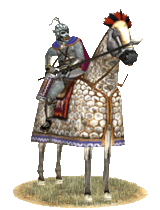 Having no access to many of the Hetairoi of Alexander from which the other Successors formed their heavy cavalry arm, the Baktrians decided to include both Iranians and Greeks in a new force of Hetairoi, supported by the type of huge estates that were required to comfortably arm such a force. Their massive horses are fully barded with iron lamellar. The riders of these horses wear iron plate reinforced with mail at the joints and lamellar leggings. Their helmets were of a Thracian type, but with a face mask made to look like a roaring lion. They carry the xyston and ride with all the prowess of the steppe peoples from which many are descended. In addition, they are armed with a long kopis as well, which is a common weapon in the lands of Baktria and gives an armor smashing punch to these already deadly cavalry. As can be surmised, they are exceedingly expensive, but are probably the heaviest cavalry that can be found on the battlefield. They are so massively armored that they needn’t fear anything but bristling walls of spear points. Having no access to many of the Hetairoi of Alexander from which the other Successors formed their heavy cavalry arm, the Baktrians decided to include both Iranians and Greeks in a new force of Hetairoi, supported by the type of huge estates that were required to comfortably arm such a force. Their massive horses are fully barded with iron lamellar. The riders of these horses wear iron plate reinforced with mail at the joints and lamellar leggings. Their helmets were of a Thracian type, but with a face mask made to look like a roaring lion. They carry the xyston and ride with all the prowess of the steppe peoples from which many are descended. In addition, they are armed with a long kopis as well, which is a common weapon in the lands of Baktria and gives an armor smashing punch to these already deadly cavalry. As can be surmised, they are exceedingly expensive, but are probably the heaviest cavalry that can be found on the battlefield. They are so massively armored that they needn’t fear anything but bristling walls of spear points.
Historically, the elite Baktrian cavalry were extremely heavy cataphracts retaining Greek tradition and training. The combination of natural steppe skill and Greek training ethos has rendered these men (who are often of mixed Greco-Iranian stock) some of the finest horsemen in the known world. They are often known to trot into battle and charge at the very last moment, sending bodies flying and riding down enemies with sheer momentum. In their whole history, they were never outfought, not in any battle. The estates from which they were supported were eventually eroded from nomad attacks and the Baktrian Kingdom could simply not afford them any longer. They truly must have been a sight to behold. Perhaps if a worthy leader had taken the throne of Baktria, these men could have cut down those who opposed them, like their Makedonian, Skythian and Persian ancestors.
Elephantes Indikoi (Indian Elephants)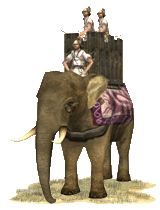 Imported from the regions around the old Eastern Persian provinces, Elephantes Indikoi are an exceptionally valuable resource in combat, very popular among Alexandros' Diadochoi. Towering over most other creatures, they can easily scare men and horses alike, with both their size and smell, though elaborate bells and trappings often add to their intimidation. Such corps are directed by their own mahouts riding behind their heads, often a native of their own country who has spent at least two years training his beast from capture. The mahout is armored to better protect against the obvious assault that generally comes against him, launched to bypass the thick natural armor of his mount. Imported from the regions around the old Eastern Persian provinces, Elephantes Indikoi are an exceptionally valuable resource in combat, very popular among Alexandros' Diadochoi. Towering over most other creatures, they can easily scare men and horses alike, with both their size and smell, though elaborate bells and trappings often add to their intimidation. Such corps are directed by their own mahouts riding behind their heads, often a native of their own country who has spent at least two years training his beast from capture. The mahout is armored to better protect against the obvious assault that generally comes against him, launched to bypass the thick natural armor of his mount.
Elephants are best used as cavalry screens for your army, where their presence can scare away enemy cavalry. They can also be used to ram through an enemy battle line, though they are less useful when faced with loose order or phalanx infantry. Pyrrhos of Epeiros even innovated a tactic of flank screens when he fought the Romans at Heraklea. Beyond their obvious use against enemy infantry or cavalry, they can also be used in siege combat; battering down gates, though they're highly vulnerable to better prepared installations. Their greatest vulnerability is against skirmishers, slingers and archers, who can pepper them with missiles - eventually toppling them by virtue of their cumulative impact. To counter the effect of enemy skirmishers, it is often wise to array your own in opposition, or to maintain constant attacks upon each individual group.
Historically, the use of elephants in war was largely contained to India, but after the battle of Hydaspes that changed. Though Alexandros never cared over much for the animals, his successors were very much in favor of their use, organizing their own elephants into a distinct corps under their own "elephantarchos". These "Elephantes Indikoi" (Indian Elephants) were imported for war in the West from the old Eastern Persian provinces around Baktria, Gandhara, Sattagydia, and Sind - though most originally hailed from the regions directly around the river the natives call the Sindhu. In the first wars of succession, each Diadochoi had a contingent of Indian elephants and Indian mahouts, who stayed on where they taught the Hellenes how to capture and train elephants for war. Such forces had been wreaking havoc on battle lines for centuries within the armies of Indian Rajas, and the Diadochoi used them on an equal scale (the first substantial group supposedly numbered 500 elephants total, granted to Seleukos I Nikator by his new ally Chandragupta Maurya, called "Sandrokottos" in Greek), attaching substantial political power to their possession - some officers gained temporary power and success simply by this virtue (most notably, the Eastern Satrap Eumenes).
Despite their great usefulness when properly employed, it was not unusual for elephants to cause defeat for those who employed them. If an enemy was clever enough to devise their own means to combat elephants, as was the case at the battle of Gaza when Ptolemaios planted an ‘iron spiked minefield’ to ward off elephants, or when Caesar properly utilized slingers and Scipio gaps between his infantry cohorts to channel the elephants, they could be defeated and even turned against their masters. Even pigs were used on occasion, released among elephants who were often scared of their comparatively small, darting forms. However, despite the many different weapons and stratagems being devised to fight them and the huge expenses required to maintain them, the elephant was still considered a valuable asset, maintained widely. The Arche Seleukeia even developed a corps of ‘elephant guards,' whose task was simply to defend the beasts in combat.
Other non-Hellenic powers also used Indian elephants in war, but it seems not to the same great extent. These powers started using elephants when they gained control of Indian provinces, such as the Pahlava, Kushan Empire and the Indo-Saka kingdoms.
Elephantes Kataphraktoi Indikoi (Armoured Indian Elephants)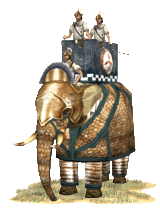 Imported from the regions around the old Eastern Persian provinces, Elephantes Kataphraktoi Indikoi are an exceptionally valuable resource in combat, very popular among Alexandros' Diadochoi. Towering over most other creatures, they can easily scare men and horses alike, with both their size and smell, though elaborate bells and trappings often add to their intimidation. Such corps are directed by their own mahouts riding behind their heads, often a native of their own country who has spent at least two years training his beast from capture. The mahout is armored to better protect against the obvious assault that generally comes against him, launched to bypass the thick natural armor of his mount. A thorakion (tower) or howdah is also attached to the elephant's back, which serves as a missile platform for a few archers. The elephant itself is also armored, protecting its head and sides and thus giving the elephants a much better chance at resisting enemy missile fire. Imported from the regions around the old Eastern Persian provinces, Elephantes Kataphraktoi Indikoi are an exceptionally valuable resource in combat, very popular among Alexandros' Diadochoi. Towering over most other creatures, they can easily scare men and horses alike, with both their size and smell, though elaborate bells and trappings often add to their intimidation. Such corps are directed by their own mahouts riding behind their heads, often a native of their own country who has spent at least two years training his beast from capture. The mahout is armored to better protect against the obvious assault that generally comes against him, launched to bypass the thick natural armor of his mount. A thorakion (tower) or howdah is also attached to the elephant's back, which serves as a missile platform for a few archers. The elephant itself is also armored, protecting its head and sides and thus giving the elephants a much better chance at resisting enemy missile fire.
Elephants are best used as cavalry screens for your army, where their presence can scare away enemy cavalry. They can also be used to ram through an enemy battle line, though they are less useful when faced with loose order or phalanx infantry. Pyrrhos of Epeiros even innovated a tactic of flank screens when he fought the Romans at Herakleia. Beyond their obvious use against enemy infantry or cavalry, they can also be used in siege combat; battering down gates, though they're highly vulnerable to better prepared installations. Their greatest vulnerability is against skirmishers, slingers and archers, who can pepper them with missiles - eventually toppling them by virtue of their cumulative impact. To counter the effect of enemy skirmishers, it is often wise to array your own in opposition, or to maintain constant attacks upon each individual group. These "towered" elephants though are much less vulnerable then their unarmored corps, well protected as they are by their own armor and skirmisher mounts of their own.
Historically, the use of elephants in war was largely contained to India, but after the battle of Hydaspes that changed. Though Alexandros never cared over much for the animals, his successors were very much in favor of their use, organizing their own elephants into a distinct corps under their own "elephantarchos". These "Elephantes Kataphraktoi Indikoi" (Armoured Indian Elephants) were imported for war in the West from the old Eastern Persian provinces around Baktria, Gandhara, Sattagydia, and Sind - though most originally hailed from the regions directly around the river the natives call the Sindhu. In the first wars of succession, each Diadochoi had a contingent of Indian elephants and Indian mahouts, who stayed on where they taught the Hellenes how to capture and train elephants for war. Such forces had been wreaking havoc on battle lines for centuries within the armies of Indian Rajas, and the Diadochoi used them on an equal scale (the first substantial group supposedly numbered 500 elephants total, granted to Seleukos I Nikator by his new ally Chandragupta Maurya, called "Sandrokottos" in Greek), attaching substantial political power to their possession - some officers gained temporary power and success simply by this virtue (most notably, the Eastern Satrap Eumenes).
However, even with many different anti-elephant weapons being used and with the huge expenses, time and effort that had to be put into maintaining an elephant herd, the elephant was still employed so it shows that it was still valued and served its purpose. The Seleukides even developed specific ‘elephant guards’ units, whose task was to solely defend these beasts. The elephant riders or the mahouts, were often called Indoi, as in the beginning they were all Indians and the majority of mahouts continued to be Indians, yet they did teach their skills to ‘westerners’ as well, as the Ptolemaioi did not have access to India yet they kept a sizeable elephant corps. The mahouts often wore protective armor as they were an obvious target for enemy missiles, even though ancient artists often portray them unarmored, which is highly likely to have been how they dressed for parades.
Other non-Hellenic powers also used Indian elephants in war, but it seems not to the same great extent. These powers started using elephants when they gained control of Indian provinces, such as the Pahlava, Kushan Empire and the Indo-Saka kingdoms.
Hindus Pattisainya (Indian Spearmen)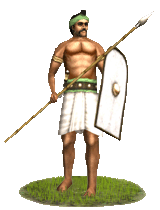 All across the lands of the East the tribes of the Hindus have spread themselves, teaming across a region larger even then the empire of the conqueror Alexandros himself. Despite their far-flung habitation, the practice of war was much the same among most of them. These Hindus Pattisainya are a fine brigade of lightly armed spearmen drawn from a number of tribes like the Gandharas and those that the Hellenes called the Aspasios, or even the Yaudheya beyond the Hindus itself. Their tribal differences occassionally spring up, but by and large they are united by their common religion - mostly some form of Buddhism, but often enough they can find accomodations with their own local or shared gods. Though armed only with a light shield and a bamboo spear, they are well suited to combat in a number of regions, and are incredibly useful auxiliaries. All across the lands of the East the tribes of the Hindus have spread themselves, teaming across a region larger even then the empire of the conqueror Alexandros himself. Despite their far-flung habitation, the practice of war was much the same among most of them. These Hindus Pattisainya are a fine brigade of lightly armed spearmen drawn from a number of tribes like the Gandharas and those that the Hellenes called the Aspasios, or even the Yaudheya beyond the Hindus itself. Their tribal differences occassionally spring up, but by and large they are united by their common religion - mostly some form of Buddhism, but often enough they can find accomodations with their own local or shared gods. Though armed only with a light shield and a bamboo spear, they are well suited to combat in a number of regions, and are incredibly useful auxiliaries.
Historically, the infantry employed by Hindus kings like Ambhi, the two Purushotthama kings of Kekeya (the two Paurava kings), or even the far off dynasts of the Audumbaras and Yaudheyas, was dominated by light armed levies like these. Particularly among the former peoples in Gandhara and farther North among the Southern Kambojas, where class restrictions on warfare were more relaxed, and peasant levies more prevelant. They fought valiantly for their kings when men like Megas Alexandros brought his campaign to the banks of the Hindus, and even more so in their own ancient epics of battle and spiritual awakening. Later on, they fought for Alexandros himself in contingents provided by his vassals, and at various times in the armies of Indo-Greek kings like Menandros and Antialkidas. In these later times, they were a huge and formidable component of Indo-Hellenic armies, but had more restricted or varied origins. Under Menandros, they were probably heavily drawn from the Madras, Sibis, Kekeyas, and other Gandhara peoples - though local levies from among the Yaudheyas, Audumbaras, and other Buddhist peoples of his massive empire - while the armies of Zoilos or Lysias probably included more peoples of the West-Central Hindus region. Later, under the Saka, they probably served mostly as light garrison or support troops for their countrymen in the archer corps or the King's Hellenic infantry.
Hindus Patiyodha (Indian Longbowmen)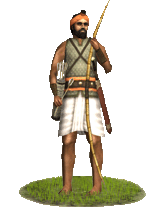 The Hindus tribes west of the Indus are famed for their use of massive longbows made from cane and strung with tough silken bowstrings. These bows allow them to launch arrows at a tremendous range, making their users essentially immune to enemy horse archers and projectiles. They wear no armor and rely simply on their skills with the large Indian sword to get them out of less certain melee encounters. These Indians can be the lynchpin of a proper 'wearing down' before a dedicated melee engagement, thinning the ranks that the more dedicated melee fighters will encounter. The Hindus tribes west of the Indus are famed for their use of massive longbows made from cane and strung with tough silken bowstrings. These bows allow them to launch arrows at a tremendous range, making their users essentially immune to enemy horse archers and projectiles. They wear no armor and rely simply on their skills with the large Indian sword to get them out of less certain melee encounters. These Indians can be the lynchpin of a proper 'wearing down' before a dedicated melee engagement, thinning the ranks that the more dedicated melee fighters will encounter.
Historically, the longbowmen of India were a famous and fearsome force, utilized by every effective army ever mobilized in the region - even Alexander the Great took advantage of their easy availability, receiving a number of them in the levy contingents from his newly acquired vassal kings. A century later, as the Baktrian Kings became more settled and grew into the roles of a "Raja," as opposed to a traditional Hellenic Basileos, such archers became a more regular component of their native levy - probably freeing most Hellenes from the lower orders of the psiloi, in order to concentrate them in their "national" phalanx. Even the archery-oriented Saka used them to augment their own foot archers, or to support their cavalry divisions, expanded as more and more cultivated land came under their power. Forunately for the Baktrians, Saka, and even the occassional non-regional power to invade India, longbowmen are a regular feature of the local military infrastructure, and easily accessable to anyone.
Sreni Pattya Yoddaha (Infantry Guild Warriors)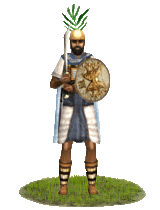 Self regulating professional guilds, called ‘Sreni’ formed an important part of the social fabric of the Indian sub-continent in the 3rd century B.C. Some of these were guilds of war-craft, and their members dedicated their lifetime to the art of war, conducting their affairs according to a strict code of ethics. Self regulating professional guilds, called ‘Sreni’ formed an important part of the social fabric of the Indian sub-continent in the 3rd century B.C. Some of these were guilds of war-craft, and their members dedicated their lifetime to the art of war, conducting their affairs according to a strict code of ethics.
These infantry are equipped with the best that money can buy. For defense, they wear armour of iron and brass scales over a quilted cotton cuirass, with additional protection for the arms, legs and shoulders. For offense, they carry a large ‘sword-axe’ made of high quality iron from the mines of Magadha. At this point in history, the metal-craft of Magadha was well in advance of anything in the Mediterranean and so the equipment was of very high quality.
Heavily armoured, steeped in a warrior tradition and bound by a professional code of warrior ethics, these troops can be relied on to hold the battle line in the most trying of circumstances.
Historically, most of what we know of ancient Indian armies comes from Kautilya’s ‘Arthashastra’ (a manual on statecraft) and sparse depictions in Buddhist art (notably at Barhut and Ajanta). Kautilya makes it clear that troops from the ‘Sreni’ formed an integral part of the royal army and were trusted second only to the king’s own standing army. Scattered references from our sources also indicate that professional mercenary companies from India were in regular employment, fighting for and against the Achaemenids, and later for and against Alexander and his successors.
Kamboja Asvaka Ksatriya (Indo-Iranian Light Cavalry)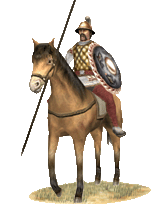 Master horsemen and horse traders, Kambojas never leave an opportunity to plunder using their light horse troops. Living on both sides of the Khyber Pass, they were a part of the "Arya" races which stormed and conquered India, some 1500 years before. Their own name was a mistaken identity by the Helllenes of Alexandros who called them "Assakenoi" whereas they were "Asvaka" or "horsemen" in Sanskrit. Losing badly to Alexander, they befriended his descendants, their Greco-Baktrian overlords and along with them they invaded India reaching as far as present day Bangladesh. They repeated this feat, but with their new Lords, the Sakae who overran Greek Baktria in the end of 1st centrury BCE. Their helmet is an evolved Boiotian one, and their primary cuirass is a quilted silk one. Untreated (so called "dirty") silk had very good anti-missile qualities, which Kambojas facing Indian foot archers and Steppen Horse archers would deffinitely appreciate. They wear Iranian dotted pantaloons and have pteryges to cover their genitals. Their weapons are clearly Hellenic: round "Aspis" shield, a short kontos spear that could be held underarm in a stance reminding that of the knights, and a sturdy kopis for the time when the spear gave way. It is safe to assume that they would show the same faith to all their overlords, whoever they might be. Master horsemen and horse traders, Kambojas never leave an opportunity to plunder using their light horse troops. Living on both sides of the Khyber Pass, they were a part of the "Arya" races which stormed and conquered India, some 1500 years before. Their own name was a mistaken identity by the Helllenes of Alexandros who called them "Assakenoi" whereas they were "Asvaka" or "horsemen" in Sanskrit. Losing badly to Alexander, they befriended his descendants, their Greco-Baktrian overlords and along with them they invaded India reaching as far as present day Bangladesh. They repeated this feat, but with their new Lords, the Sakae who overran Greek Baktria in the end of 1st centrury BCE. Their helmet is an evolved Boiotian one, and their primary cuirass is a quilted silk one. Untreated (so called "dirty") silk had very good anti-missile qualities, which Kambojas facing Indian foot archers and Steppen Horse archers would deffinitely appreciate. They wear Iranian dotted pantaloons and have pteryges to cover their genitals. Their weapons are clearly Hellenic: round "Aspis" shield, a short kontos spear that could be held underarm in a stance reminding that of the knights, and a sturdy kopis for the time when the spear gave way. It is safe to assume that they would show the same faith to all their overlords, whoever they might be.
Historically, Kamboja, were among the westernmost of the 16 or so nations (mahajanapadas) which comprised the Archaic (Vedic) Indian world. IndoIranians to the utmost, they presumably took the name from river Kabul (then named Kaboj) or from Kam(region)-used mostly in those areas to this date- and Bhoja(owner). They must have a major impact on the Achaimenid Persians who conquered them, as Cyrus the great (Kurush) named his son Kambyses (Kambujiya) the 3rd, presumably after a Mythical hero, Kambujiya (Kamboja of Shantiparava),who led the Iranians against a Vedic king Kuvalashava, defeating him in the battle and wresting a prized sword from his lineage. Thus, it can be easily understood that common language and mythical bonds made Achaimenids and Kambojas friendly to one another.
This good relation with their overlords would change later, as the Kamboja clans—the Aspasioi of Kunar/Alishang valleys, the Guraeans of the Guraeus (Panjkora) valley and the Assakenoi of the Swat and Buner valleys fought the Makedones to a man. When worse came to worst, even the Assakenoi(Ashvakayanas) Kamboj women had taken up arms and fought the invaders side by side with their husbands, thus preferring "a glorious death to a life of dishonor". In fact Alexander spent a couple of years at present day Afghanistan and NW Pakistan fighting Kamboja clans. These highlanders, designated as "parvatiya Ayudhajivinah" in Panini's Astadhyayi were rebellious, fiercely independent and freedom-loving clans who never easily yielded to any overlord. Modern historians have this to say on them ...."It was indeed a hard work for Alexander to take their strongholds, of which Massaga and Aornus need special mention (A. K. Narain, 'Alexander the Great') and "A tribute must be made to the vision and sagacity of Alexander because he realised that without reducing these highlanders, his march into India would neither be secure nor effective."(History of Punjab, Vol I, 1997, p 225, Dr Buddha Prakash). This was the wonder and the tragedy of those people. That they controled the way to India, thus they had to be either conquered or destroyed.
Survivors were a lot less willing to fight off superior forces than their ancestors. Instead they played along with the plans of their overlords and managed to survive and prosper. They must have been hellenized to a degree, as is evident by the following excrept of Assalaya Sutta of Majjhima Nikaya, the second book of the Sutta Pitaka (written probably around the end of first century BCE or 2nd centruy AD)- Buddha says:"Have you heard that in the countries of Yona(yonaratthan) [greek territory] and Kamboja (kambojaratthan) and other adjacent districts there are only two castes, master and slave? And having been a master one becomes a slave? Having been a slave, one becomes a Master? - Yes, I have heard this, Sir, in Yona and Kamboja...having been a slave, one becomes a master." If we compare this to the Asoka's 13th edict where the country of the Yonas is mentioned as the only place where the caste system doesn't exist. Of course it was written more than 100 years earlier than that Buddhist script. Kambojas took part willingly in the Baktrian invasion of India which must have led to the creation of the separate Indo-Greek state by 186 BCE (time when the Indo-Greek calendar begins) and as a spoil of war, they were allowed to settle along their Indo-Greek Overlords in India, both all along the Indus river and in the center of India Mathura and eastern on.
Indians wrote the following, according to Majjhima Nikaya 43.1.3. ; Ganapatha II.1.72; Harivamsa 14.16. "Both people are attested to follow common culture, social customs and manners like supporting short cropped hair, non-entertainment of Brahmanas in their countries and observing two varna=caste/class (Arya and Dasa=master and slave) social system instead of chatur-varna observed by the Indo-Aryans ". Greco-Baktrians managed to control western and Central India in a few decades. That wouldn't have been possible without the help of Buddhist local population (who were persecuted by the Hindu majority), and their vassals, Bahlikas (Baktrioi Hippeis) and Kamboja Asvaka Ksatriyas, excellent horsemen, to compliment their own cavalry, chosen Phallanxes, Hypaspistai and Agemata.
Manusmriti (X/43-44) lists the Yavanas with the Kambojas, Sakas, Pahlavas, Paradas etc and regards them as degraded Kshatriyas (members of the warrior caste). Hence the "Ksatriya" in its name.
The "Yonakambojesu" expression (Yonas and Kambojas alike) in Ashoka's Thirteen Rock Edict as well as in the Majjhima Nikaya powerfully attest very close relations of the Kambojas with the Yavanas. Mahabharata contains references to Yavanas and Kambojas having conquered Mathura. Kambojas had also entered India and spread into whole of North India, especially in (present day) Punjab and Uttar Pradesh. According to Agni Purana (A hindu holy text), it locates two Kamboja settlements in India itself. Kambhoja in south-west India and Kamboja in southern parts of India, even if it can be debated that this account was much later than our timeline.
When the Saka-Rauka conquered the Baktrian state, and were preparing to move into India to fight the Indo-Greeks. Along with 4 other tribes (Bahlikas, Parama Kambojas, Rishikas, Paradas) they were among the armies of the Saka-Rauka who invaded and occupied India.
Illustrious traders that they were, they reached even unto Taprobane, present day Sri Lanka. Cave inscriptions found in Anuradhapura which strongly attest the existence of one Kamboja Sangha (Goshatha) and Grand Kamboja Guilds in ancient Sinhala. These inscriptions are believed to belong to second century BCE (Dr S. Paranavitana). Later on, centur.es later a Kamboja trader is said to have reached into a country in Indochina, whose reign he acquired, giving it the name of his people. Presently it is known as Cambodia.
Throughout the Indian literature, the Kambojas are honoured for their horses. All major Indian religions have a lot to say about them. Jain Canon Uttaradhyana-Sutra informs us that a trained Kamboja horse exceeded all other horses in speed and no noise could ever frighten it. The epics, Puranas and numerous other ancient Sanskrit texts all agree that the horses of the Kamboja, Bahlika and Sindhu regions were the finest breed.
Sauptikaparva of Mahabharata ranks the horses from Kamboja as of the finest breed. Bhishamaparva of Mahabharata refers to the quality war horses from various lands and puts the steeds from the Kamboja at the head of the list specifically styling them as the leaders (Mukhyanam) among the best breed of horses.
Taxilan Agema (Indo-Iranian Heavy cavalry)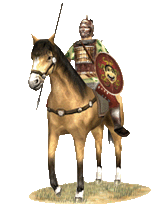 Heavy cavalry, exclusive to the Gandhara region, those mostly Indo-Iranian horsemen combine elements of both Hellenic weapon and armor mastery, and Indian excellent iron forging traditions. Wearing a Hellenic facemask made to resemble the syncretic deity of Zeus-Ahura Mazda with his distinct outflowing sunrays, armed with a small "cavalry" aspis shield, a spear and a kopis for close work and a leather cuirass, those alone would classify him a heavy cavalry. Yet, worn above the leather cuirass is the true Mauryan ion forging skills evident. Right on the edge of the facemask begin a circular leather shoulder and neck protector, with iron and bronze scales intertwined. His cloak, heavy at the shoulders for enhanced slash protection is basically two parts, that are tied together prior to battle. On top of his leather cuirass, a wooden frame is held together by leather straps. Therein either metal shards or rectangular lamellae are held together by the wooden frame, making a very Indian style "framed breastplate", on top of his hardened leather cuirass. An Iranian style pantaloon and perikneimeides' also known as greaves complete the picture. Heavy cavalry, exclusive to the Gandhara region, those mostly Indo-Iranian horsemen combine elements of both Hellenic weapon and armor mastery, and Indian excellent iron forging traditions. Wearing a Hellenic facemask made to resemble the syncretic deity of Zeus-Ahura Mazda with his distinct outflowing sunrays, armed with a small "cavalry" aspis shield, a spear and a kopis for close work and a leather cuirass, those alone would classify him a heavy cavalry. Yet, worn above the leather cuirass is the true Mauryan ion forging skills evident. Right on the edge of the facemask begin a circular leather shoulder and neck protector, with iron and bronze scales intertwined. His cloak, heavy at the shoulders for enhanced slash protection is basically two parts, that are tied together prior to battle. On top of his leather cuirass, a wooden frame is held together by leather straps. Therein either metal shards or rectangular lamellae are held together by the wooden frame, making a very Indian style "framed breastplate", on top of his hardened leather cuirass. An Iranian style pantaloon and perikneimeides' also known as greaves complete the picture.
Historicaly, closely after Alexandros died, his Indian pocessions became the property of one of the greatest Indian dynasties to come out of the Magadha area, the Mauryans, named after its founder Chandragupta Maurya. Be it his immitating of the tolerant Seleukid ways, be it that he felt gratitude toward the "Yavanas/Yonakas" mercenaries who helped him assume the throne, Chandragupta Maurya, allowed free reign on all. This is further demonstrated by his grandson Asoka Maurya, in his Bilingual (Greek and Aramaic) inscriptions at Kandahar/Gandahara (Shar-i-kuna). (3rd century BCE). They were preserved at the Kabul Museum.
Today they have disappeared. There he had written among other verses which proclaimed abstaining from killing..."and obedient to their father and mother and to the elders, in opposition to the past also in the future, by so acting on every occasion, they will live better and more happily". It has been suggested that Ashoka has had a quarter Greek blood, as his grandfather Chandragupta did marry Seleukos' daughter, but that is beside the point. It may be that his supposed quarter Greek ancestry did make him more hospitable towards Yavanas and other Northwestern "barbarians", but it is more prudent to assume that Ashoka had studied government, and had learned about Seleukos forging a kingdom out of nothing through "tolerance" and "synthesis" of foreign elements. This process would come to be known thousands of years later in a land far far away as "E pluribus unum".
It is rare that a fusion of cultures, ideas, religions and yes, warrior cultures happens. It is however very fortunate that in the cases that it does, units that combine all the great aspects of their perspective "schools of thought" so far as military technology of the time. The Greek facemask, maybe the best form of facial protection at the time would start a legacy that would last for at least 1500 years across all Asia. The small round shield, by no means a Greek invention, is still in use in India, in Kalaripayattu martial arts discipline. Kopis sword, is now known as Khukri and the resemblance to the Kopis is uncanny. The cuirass has certainly evolved away from what the Taxilan Agema wear. A heavy Nissean or Kambojan horse is what the Taxilan agema is mounted on, and even if it isn't armored, nobody can say the same for his rider. Taxilan agema will fight for whomever owns the regions that they are recruited in, and do so until they die, or their horses collapse from under them.
Peltastai Indohellenikoi (Indo-Greek Peltasts)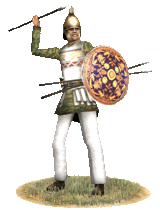 After the kingdom of Baktria attacked and seized its Indian possessions, it found the Greeks who had been living there had adapted somewhat to native ways. Gone was the close phalanx formation and the long spear, replaced by a somewhat looser but more skilled melee formation. They adopted a Phrygian style helmet, light cotton Thracian trousers, and javelins, in addition to a smaller and lighter shield. This allows them to be excellent elephant killers, as well as defeat the more lightly armored infantry of the east. They can be used as a good medium infantry, to screen the flanks and protect against elephants and cavalry while the Thureophoroi deliver the fatal melee blow. After the kingdom of Baktria attacked and seized its Indian possessions, it found the Greeks who had been living there had adapted somewhat to native ways. Gone was the close phalanx formation and the long spear, replaced by a somewhat looser but more skilled melee formation. They adopted a Phrygian style helmet, light cotton Thracian trousers, and javelins, in addition to a smaller and lighter shield. This allows them to be excellent elephant killers, as well as defeat the more lightly armored infantry of the east. They can be used as a good medium infantry, to screen the flanks and protect against elephants and cavalry while the Thureophoroi deliver the fatal melee blow.
Historically, the Indo-Greeks adapted quite well to the environment of India and prospered. Many became Buddhists, though they still remained fierce warriors, true to their Hellenic forbearers. They are an excellent medium infantry, well able to compliment other troop types and provide a versatile unit against light cavalry and elephants.
Hoplitai Indohellenikoi (Indo-Hellenic Medium Infantry)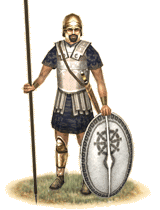 Hoplitai Indoi are the lightest component of the regular Indo-Greek phalanx line, equipped with fairly light linothrax and ptyrges, and an equally light helm, though a heavy thuroes and bronze greaves afford them substantially greater defensive coverage then the traditional hoplitai of distant Hellas. They are arrayed in a traditional, non-Makedonian phalanx to prevent a need for more regular drilling and equipped with a thuroes to compensate for the lesser defensive value inherint in this lighter formation. In Baktrian and Saka armies, they are best used to support the more expert and elite linesman around them, the Pezhetairoi Indoi and Hoplitai Indoi Beltistoi in the case of the burgeoning Baktrian empire and the Hoplitai Hellenikoi and Agema Hellenikon in the case of the Philhellenic Saka Kingdom. Hoplitai Indoi are the lightest component of the regular Indo-Greek phalanx line, equipped with fairly light linothrax and ptyrges, and an equally light helm, though a heavy thuroes and bronze greaves afford them substantially greater defensive coverage then the traditional hoplitai of distant Hellas. They are arrayed in a traditional, non-Makedonian phalanx to prevent a need for more regular drilling and equipped with a thuroes to compensate for the lesser defensive value inherint in this lighter formation. In Baktrian and Saka armies, they are best used to support the more expert and elite linesman around them, the Pezhetairoi Indoi and Hoplitai Indoi Beltistoi in the case of the burgeoning Baktrian empire and the Hoplitai Hellenikoi and Agema Hellenikon in the case of the Philhellenic Saka Kingdom.
Historically, when the Baktrian Kingdom began its fairly rapid conquest of Northern India, they transplanted a large number of Iranians - Bahlikas and Kambojas in the native tongues - with them, serving variously as lower-order administrators or yoemen in their armies, immigrants, or in their massive auxilliary corps. These men, now settled in India and affected by both the native and conquorer's culture, along with partially Hellenized local Indians and the part-Indian children of Hellenic families, formed the bulk of this varied local levy. After the conversion of the Baktrian King Menander to Buddhism, as reported in various later Buddhist texts, they likely evolved into the bulk of his successors' light linemen - particularly his own locally supported dynasty, as represented by his son Strato and both their various namesakes. Other dynasties, like that of Zoilos centered in Arachosia or that of Antialkidas at Taxila also utilized such forces, though the former's ranks probably held more soldiers of Iranian extraction and the latter of loyal dharmayavanas (Hellenized Indiands). In the time of Hellenic rule, they had a fairly limited role and their position in Baktrian armies reflects this, but under the Saka, such men were a major component of their well-trained local regulars, second in the region only to the Agema Hellenikon.
Indohellenikoi Eugeneis Hoplitai (Indo-Greek Noble Hoplites)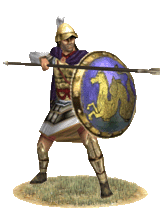 Indohellenikoi Eugeneis Hoplitai are the elite infantrymen of Hellenic India, drawn from the Indo-Greek population, be they descendants of those settled during Alexander’s invasion or recent immigrants from Baktria. They wear an evolved Boiotian helmet that offers protection against both weapons and the sun so it won’t obstruct their view. They also wear elaborately decorated bronze cuirasses with Indian motifs, pteryges, perikneimides (full greaves) and of course a heavy bronze hoplon shield to complete their armor. An iron-tipped spear is their primary weapon, but should the need arise they are also armed with an evolved kopis or Khukhri as the Indians call it, a medium sized sword of Indian steel made for slashing. In fact, when compared to the Hoplites of old, they are more mobile and have better vision of the battlefield, due to the evolved Boiotian helmet they wear. They are also equally skillful with spear or sword. These men are among the finest soldiers in India or at least in the Indus valley and western Gangetic plains and can be relied on to do their duty to a man, but a wise strategos knows to use these troops with care as there are few Hellenes in the East and their numbers are not easily replaced. In fact they, along with the Sreni (Professional guild warriors) were the ones that the Indogreek kings relied upon to hold the line. Indohellenikoi Eugeneis Hoplitai are the elite infantrymen of Hellenic India, drawn from the Indo-Greek population, be they descendants of those settled during Alexander’s invasion or recent immigrants from Baktria. They wear an evolved Boiotian helmet that offers protection against both weapons and the sun so it won’t obstruct their view. They also wear elaborately decorated bronze cuirasses with Indian motifs, pteryges, perikneimides (full greaves) and of course a heavy bronze hoplon shield to complete their armor. An iron-tipped spear is their primary weapon, but should the need arise they are also armed with an evolved kopis or Khukhri as the Indians call it, a medium sized sword of Indian steel made for slashing. In fact, when compared to the Hoplites of old, they are more mobile and have better vision of the battlefield, due to the evolved Boiotian helmet they wear. They are also equally skillful with spear or sword. These men are among the finest soldiers in India or at least in the Indus valley and western Gangetic plains and can be relied on to do their duty to a man, but a wise strategos knows to use these troops with care as there are few Hellenes in the East and their numbers are not easily replaced. In fact they, along with the Sreni (Professional guild warriors) were the ones that the Indogreek kings relied upon to hold the line.
Historically, infantrymen like these were scarce, but they still built up a fearsome reputation and Hellenes were sought after as bodyguards all over India, there is even mention of Hellenes serving as bodyguards in far away Sri Lanka. The Indo-Greek kingdoms themselves can be called Baktrian successor kingdoms as it was the Hellenes of Baktria who invaded India after the Mauryan collapse and it was Baktrian Hellenic nobles who made themselves lords in their new conquests. The Indo-Greek kingdoms were established during the civil wars and rebellions that were common in the Graeco-Baktrian Empire after 200 BC and after Baktria itself was overrun by the Saka and other nomadic groups. Evidence indicates that most infantrymen in the far eastern Hellenic kingdoms were drawn from subject peoples, except the most elite units who were made up of Hellenes and thoroughly Hellenized subjects. The same seems to have been in the case of the Indo-Greeks too, who levied large numbers of Indians to serve as infantry. Some sources indicate that Indian infantry apparently were poorly disciplined and had a low morale and thus prone to desert or rout. One battle used to illustrate this is the siege of Baktra, where 300 horsemen lead by Eukratides sallied out from the city and routed the Indo-Greek King Demetrios II’s army of 60000 men all the way to the Indus River, according to Justin (XLI,6). Apparently after this more reliable elite infantry units were raised and dispersed among the Indian infantry to try and maintain morale and lead by example.
Indohellenikoi Eugeneis Hoplitai were infantrymen who served in the Indo-Greek Kingdoms as crack troops, but units like these were likely to have fought in Baktrian armies as well, one reason being that Baktria did field elite infantry units of their own and these men would simply have been an Indo-Greek variant of those. The Saka, knew a good thing when they saw it, so not only did they keep them as a fighting force, enhancing them with their own people and fighting elements, meaning a bigger emphasis on sword than spear, a gradual shift that would take centuries to complete.
Graphical evidence includes a frieze showing a hoplite in full gear in a relief wearing the chlamys found in Butkara, National Museum of Oriental Art. There is also a Hero Stone in southern India, a dead Ksatriyas' grave, showing two rows of over hand holding spearmen, armed also with an aspis shield attacking each other, with the Hero dieing a glorious death.
Some Puranic (Indian epic) references on them... Kane quotes several minor texts in which Yavanas (Greeks) are described as barbarians (mlecchas), eaters of cow's flesh, contradictory thinkers, and having their own peculiar manner of dress and trimming of hair. (Indians at the time wore their hair long and in topknots). In other parts they are shown as different to mlecchas, above them as if leading them.
Several references to the Yavanas and their kingdom occur in Tamil epic literature and in the Ceylonese chronicle Culavamsa. In the fifth part of the Tamil epic poem Cillappatikaram, for example, the abodes of wealthy Yavanas and mercenary Yavana swordsmen are described. A Yavana kingdom existing in the North is also mentioned.
In Malinda Panha (the Buddhist monk Nagasena's account of a meeting with King Milinda or Menandros in Euthydemia, present day Sind), when the King is cornered on a difficult philosophical question, his "500 Greeks" exclaim in one voice..." Now get out of that if you can" in a most jovial mood (1st chapter). Later on they take part on the discussion as if they were expected to in some way. This indicates that they must have been pretty close to the king, the infantry part of the Basilikon Agema (King's bodyguards). In another part, he explains of a prepared military force, who is always ready for war.
The Saka used this elite force to further cement their Indian state. In time it became a mix of Yavanas, Saka and Indians, who in turn became the majority. Some Saka customs remained with them though, such as the "Ultimate Sacrifice" called "Saka" in which all those who take part, fight to the last man and either succeed or die fighting. It is not known whether a connection exists between those "Noble elites" and the Rajput-ra or "King sons'" , but the latter had that "Saka" custom as a ritual in war. Also, some of the Rajput family emblems resemble the Makedonian 16 pointed sun, which was Megas Alexandros' emblem when he started out the campaign which led to India, so many centuries before. Rajputs from the lower Indus region, in the 10th century AD fled Islamic conquest to Nepal and there they evolved into the elite Nepalese Ghurkas, who to this day carry an evolved Kopis (Khukri) and count the time by the Saka calendar.
Asabârân-î Haurâvatîsh (Arachosian Skirmisher Cavalry)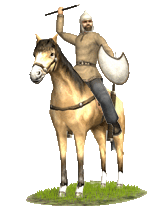 These horsemen from Arachosia are best used in a harassing role and can be very useful trying to tempt enemy heavy cavalry to mount a charge in a vain attempt to catch them. They would be wearing the Persian Kyrbasia, a soft grey-white cloth cap extending down around the neck, made of fabric and able to be pulled down over his face when marching through desert regions. They would wear dirty grey sheepskin coats with bright embroidered trim. They would wear baggy embroidered dark red trousers and knee high, brown leather boots. A coarse rain resistant felt cape, or cherkesska was also donned in winter. Also worn was a leather belt with elaborate buckles, which are decorative in themselves and used to support weapons. They would have a spear and 3-4 javelins in two embossed leather cases mounted just behind the saddle on either side. Up to as many as 6-8 such javelins cold be carried in all the cases. Their protection would be enhanced by a small crescent shaped 'Taka' shield. The brightly coloured saddle cushion would be u-shaped and made of sheepskin or cloth and stuffed with straw. These horsemen from Arachosia are best used in a harassing role and can be very useful trying to tempt enemy heavy cavalry to mount a charge in a vain attempt to catch them. They would be wearing the Persian Kyrbasia, a soft grey-white cloth cap extending down around the neck, made of fabric and able to be pulled down over his face when marching through desert regions. They would wear dirty grey sheepskin coats with bright embroidered trim. They would wear baggy embroidered dark red trousers and knee high, brown leather boots. A coarse rain resistant felt cape, or cherkesska was also donned in winter. Also worn was a leather belt with elaborate buckles, which are decorative in themselves and used to support weapons. They would have a spear and 3-4 javelins in two embossed leather cases mounted just behind the saddle on either side. Up to as many as 6-8 such javelins cold be carried in all the cases. Their protection would be enhanced by a small crescent shaped 'Taka' shield. The brightly coloured saddle cushion would be u-shaped and made of sheepskin or cloth and stuffed with straw.
Historically; Armed chiefly with javelins these horsemen hail from Arachosia, Bactria, Sogdiana, and similarly equipped light cavalry was supplied by the levy from Persis and Media. The flexible nature of this light cavalry makes them well suited to the fluid, aggressive style of warfare so common on the eastern frontiers. Mounted on a swift horse, armed with nothing but a small crescent shaped 'Taka' shield, short spear, and a handful of javelins these swift moving horsemen can be deadly. Their small, nimble mountain ponies can negotiate most terrain easily, and they're capable enough to survive contact with the enemy, but their strength remains in maintaining their loose style of fighting. Equipped with javelins these cavalry would advance on their target at less than a gallop. As each rank came into range, these warriors would turn away, hurling their javelins at the target, and retire to safety before the enemy could retaliate. The result is often a swirling mass of charging and counter charging horsemen as the light horse would reform to charge again.
Daha Baexdzhyntae (Dahae Riders)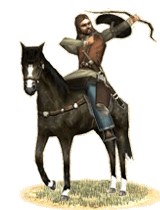 Dahae Riders carry a long spear and a shield besides their bows and are willing to press home a charge if circumstances are right. Even more significantly, they maintain a very useful tactical flexibility as they can skirmish and put their bows to very good use against solidly formed enemies that would repulse a headlong charge. As such, they are some of the finest light horsemen available to the Arsacid Kings of Parthia, the Hellenistic monarchs of Baktria, powerful nomadic rulers or anyone who manages to have them as either mercenaries, allies or nominal subjects. Dahae Riders carry a long spear and a shield besides their bows and are willing to press home a charge if circumstances are right. Even more significantly, they maintain a very useful tactical flexibility as they can skirmish and put their bows to very good use against solidly formed enemies that would repulse a headlong charge. As such, they are some of the finest light horsemen available to the Arsacid Kings of Parthia, the Hellenistic monarchs of Baktria, powerful nomadic rulers or anyone who manages to have them as either mercenaries, allies or nominal subjects.
Historically, the Daha, which is the Persian word for "robbers", were a tribe who held the lands to the northeast of Persia. The Parthians themselves were a branch of this people. In common usage the term was used to denote any of the nomadic raiders who made life difficult for the settled peoples of Persia. These raiders would descend on Persian settlements and villages to pillage and burn when the opportunity presented itself. They would be mounted on the steppe pony, renowned for it's courage and endurance. These animals only needed to be watered once a day, and they could dig for grass under the snow, which eliminated the army's need to carry feed. These are strong animals, twelve or thirteen hands high, with powerful chests and necks, large hook-nosed heads and well-built legs; they had a very fast gait. they were hardy and invaluable for long distances. astride small shaggy ponies Many of these horses could carry their masters a hundred miles between dawn and sunset and the same horse would pass the night unsheltered, in pouring rain and sub-zero temperatures, without taking harm from these harsh conditions. As such they are some of the finest light horsemen available to the Arcsacid Kings of Parthia.
|
 |
|
 |






















|